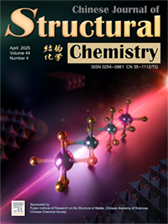
Cover Picture
High thermal conductivity in Ga2TeO6 crystals: Synergistic effects of rigid polyhedral frameworks and stereochemically inert cations
Ziyi Liu, Feifei Guo*, Tingting Cao, Youxuan Sun, Xutang Tao, Zeliang Gao* Submit a Manuscript
High thermal conductivity in Ga2TeO6 crystals: Synergistic effects of rigid polyhedral frameworks and stereochemically inert cations
Ziyi Liu, Feifei Guo*, Tingting Cao, Youxuan Sun, Xutang Tao, Zeliang Gao* Submit a Manuscript
Surface gallium hydride on Ga2O3 polymorphs: A comparative solid-state NMR study
Honglin Gao, Chunlin Yuan, Hongyu Chen, Aiyi Dong, Pan Gao*, Guangjin Hou*
Chin. J. Struct. Chem., 2025, 44(4), 100561. DOI: 10.1016/j.cjsc.2025.100561
April 1, 2025
Gallium hydride; Solid-state NMR; J-coupling; Surface configuration; Dissociation mechanism
ABSTRACT
As a highly reactive reaction intermediate, surface gallium hydride (Ga–H) has garnered significant attention due to its critical role in various catalytic reactions. However, the detailed experimental characterization of this unique species remains challenging. Recently, we have demonstrated that solid-state NMR can be an effective tool for studying surface Ga–H. In this work, we report a comparative solid-state NMR study on H2 activation over different Ga2O3 polymorphs, specifically α-, β- and γ-Ga2O3. 1H solid-state NMR enabled the identification of Ga–H species formed on all the three samples following high-temperature H2 treatment. The characteristic 1H NMR signals of Ga–H species are resolved using J-coupling-based double-resonance NMR methods, revealing highly similar lineshapes of Ga–H for all the Ga2O3 samples. This suggests potentially similar surface Ga–H configurations among different Ga2O3 polymorphs. In addition, the local hydrogen environments on the oxide surfaces are further explored using two-dimensional (2D) 1H–1H homonuclear correlation spectra, revealing multiple spatially proximate Ga–H and Ga–H/–OH pairs on different Ga2O3 polymorphs. These findings provide insights into the potential mechanism of H2 dissociation. Overall, this work offers new perspectives on the local structure of surface Ga–H on Ga2O3, and the analytical approach presented here can be further extended to the study of other Ga-based catalysts and other metal hydride species.







